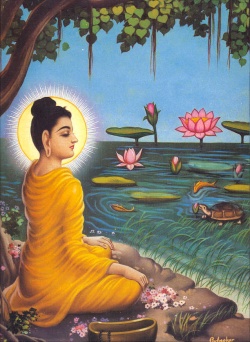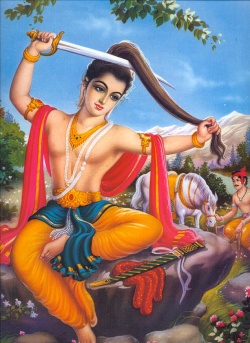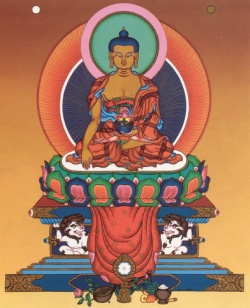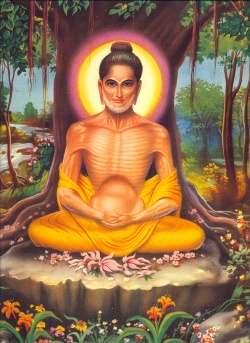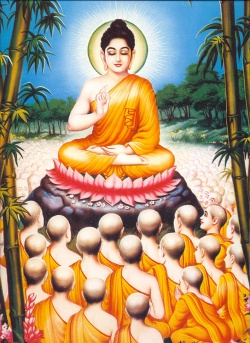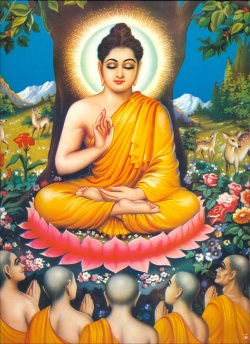Difference between revisions of "Siddhartha Gautama ca. 563 - ca. 483 BC"
(Created page with "thumb|250px| <poem> Siddhartha Gautama lived in the present-day border area between India and Nepal in the 6th century before Christ; his exact b...") |
m (1 revision: Robo text replace 30 sept) |
||
| (10 intermediate revisions by 4 users not shown) | |||
| Line 1: | Line 1: | ||
[[File:Buddha16.jpg|thumb|250px|]] | [[File:Buddha16.jpg|thumb|250px|]] | ||
<poem> | <poem> | ||
| − | Siddhartha Gautama lived in the present-day border area between India and Nepal in the 6th century before Christ; his exact birth date is unknown. Because the life of the historical Buddha is inseparable from legend, the following text is not meant to be a historically exact biography, but a short life story based on what has been passed down by generations. The dates are based on present day historians' mainstream view. | + | [[Siddhartha Gautama]] lived in the present-day border area between [[India]] and [[Nepal]] in the 6th century before Christ; his exact [[birth]] date is unknown. Because the [[life]] of the [[historical Buddha]] is inseparable from legend, the following text is not meant to be a historically exact biography, but a short [[life]] story based on what has been passed down by generations. The dates are based on present day historians' mainstream [[view]]. |
| − | '''563''' BC - Birth | + | '''563''' BC - [[Birth]] |
| − | Siddhartha Gautama is born in Lumbini, near the Nepalese-Indian border to his father, King Suddhodana, ruler of the Sakya tribe, and his mother, Queen Mayadevi. The father gives his son the name of Siddhartha (=the one who obtains success and prosperity), his second name is Gautama (=name of the clan). | + | [[Siddhartha Gautama]] is born in [[Lumbini]], near the Nepalese-Indian border to his father, [[King]] [[Suddhodana]], ruler of the [[Sakya tribe]], and his mother, {{Wiki|Queen}} [[Mayadevi]]. The father gives his son the name of [[Siddhartha]] (=the one who obtains success and prosperity), his second name is [[Gautama]] (=name of the clan). |
| − | Seers predict that Siddhartha will either become a Universal Monarch or a Buddha. Asita, the wisest of the seers, is sure that he will become a Buddha (=one who has supreme knowledge). His mother dies seven days after the birth. | + | Seers predict that [[Siddhartha]] will either become a [[Universal Monarch]] or a [[Buddha]]. [[Asita]], the wisest of the seers, is sure that he will become a [[Buddha]] (=one who has supreme [[knowledge]]). His mother [[dies]] seven days after the [[birth]]. |
'''563-547''' BC | '''563-547''' BC | ||
[[File:Buddha10.jpg|thumb|250px|]] | [[File:Buddha10.jpg|thumb|250px|]] | ||
| − | Siddhartha spends his childhood in the palace of his father at Kapilavastu, Southern Nepal, where he is raised by his aunt Mahaprajapati until the age of seven. In his early childhood, during a ploughing ceremony, Siddhartha makes his first unprecedented spiritual experience, where in the course of meditation he develops the first jhana (=meditative absorption) through concentration. | + | [[Siddhartha]] spends his childhood in the palace of his father at [[Kapilavastu]], Southern [[Nepal]], where he is raised by his aunt [[Mahaprajapati]] until the age of seven. In his early childhood, during a ploughing ceremony, [[Siddhartha]] makes his first unprecedented [[spiritual]] [[experience]], where in the course of [[meditation]] he develops the [[first jhana]] (=meditative absorption) through [[concentration]]. |
| − | As a young boy he learns the skills of a warrior, including the technical and athletic skills of man-to-man fight. Siddhartha is trained in spiritual disciplines and becomes proficient in the art of archery. | + | As a young boy he learns the skills of a [[warrior]], including the technical and athletic skills of man-to-man fight. [[Siddhartha]] is trained in [[spiritual]] [[disciplines]] and becomes proficient in the art of archery. |
'''547''' BC | '''547''' BC | ||
| − | At the early age of sixteen, he marries his beautiful cousin Princess Yasodhara, who is of equal age. | + | At the early age of sixteen, he marries his [[beautiful]] cousin {{Wiki|Princess}} Yasodhara, who is of equal age. |
'''547-533''' BC | '''547-533''' BC | ||
[[File: Buddha.jpg|thumb|250px|]] | [[File: Buddha.jpg|thumb|250px|]] | ||
| − | The young prince spends thirteen more years together with his wife in the royal court of his father. Three palaces are built for him, one for the cold season, one for the hot season, and one for the rainy season. Siddhartha enjoys the lavish court life while his father is trying to screen him from all troubles and worries. A son is born while Siddhartha is in his late twenties. | + | The young {{Wiki|prince}} spends thirteen more years together with his wife in the royal court of his father. Three palaces are built for him, one for the cold season, one for the [[hot]] season, and one for the rainy season. [[Siddhartha]] enjoys the lavish court [[life]] while his father is trying to screen him from all troubles and worries. A son is born while [[Siddhartha]] is in his late twenties. |
'''533''' BC - The Four Sights | '''533''' BC - The Four Sights | ||
| − | Despite of the amenities of life, Siddhartha is not satisfied with the mere enjoyment of fleeting pleasures due to his inquiring and contemplative nature. One day, he leaves the palace for an excursion and there he encounters what so far has been purposely veiled from him: | + | Despite of the amenities of [[life]], [[Siddhartha]] is [[not satisfied]] with the mere [[enjoyment]] of fleeting [[pleasures]] due to his inquiring and contemplative nature. One day, he leaves the palace for an excursion and there he encounters what so far has been purposely veiled from him: |
| − | He sees a decrepit old man, a diseased person, a corpse being cremated, and a sadhu (=holy man, hermit). Siddhartha realises that there is old age, sickness, and death, and that people ultimately have little control over their lives. The fourth sight provides the inspiration that leads to a dramatic change in his life. | + | He sees a decrepit old man, a diseased [[person]], a corpse [[being]] cremated, and a [[sadhu]] (=holy man, [[hermit]]). [[Siddhartha]] realises that there is [[old age]], [[sickness]], and [[death]], and that [[people]] ultimately have little control over their [[lives]]. The fourth [[sight]] provides the inspiration that leads to a dramatic change in his [[life]]. |
| − | '''533''' BC - The Renunciation | + | '''533''' BC - The [[Renunciation]] |
[[File:Buddha10.jpg|thumb|250px|]] | [[File:Buddha10.jpg|thumb|250px|]] | ||
| − | In the night of his 29th birthday, Siddhartha gives up his life as a prince and secretly leaves the court while everyone is asleep. He travels far and crosses the river Anoma, where he shaves his hair and hands over his princely garments to his groom Channa, with instructions to return them to the palace. | + | In the night of his 29th birthday, [[Siddhartha]] gives up his [[life]] as a {{Wiki|prince}} and secretly leaves the court while everyone is asleep. He travels far and crosses the [[river]] [[Anoma]], where he shaves his [[hair]] and hands over his princely garments to his groom [[Channa]], with instructions to return them to the palace. |
'''533-528''' BC | '''533-528''' BC | ||
| − | The Bodhisattva (=future Buddha), who once lived in luxury, becomes a penniless and homeless wanderer. He leads a life of self-mortification and spiritual study, becomes first a disciple of several then famous Brahman teachers, and later attracts his own disciples. | + | The [[Bodhisattva]] (=future [[Buddha]]), who once lived in luxury, becomes a penniless and homeless wanderer. He leads a [[life]] of [[self-mortification]] and [[spiritual]] study, becomes first a [[disciple]] of several then famous [[Brahman]] [[teachers]], and later attracts his own [[disciples]]. |
| − | After a long and exhausting period of searching and self-mortification, he finally becomes disillusioned with the Indian caste system, Hindu asceticism, and the religious doctrines of his time. He gives up the ascetic life and loses all of his disciples as a result. Nevertheless, he continues his search for truth through the practice of meditation. | + | After a long and exhausting period of searching and [[self-mortification]], he finally becomes disillusioned with the {{Wiki|Indian caste}} system, [[Hindu]] asceticism, and the [[religious]] [[doctrines]] of his [[time]]. He gives up the [[ascetic]] [[life]] and loses all of his [[disciples]] as a result. Nevertheless, he continues his search for [[truth]] through the practice of [[meditation]]. |
| − | April/May '''528''' BC - Enlightenment | + | April/May '''528''' BC - [[Enlightenment]] |
| − | While meditating under a Bodhi tree in Bodh-Gaya, south of Gaya in the state of Bihar, India, the Bodhisattva experiences the Great Enlightenment, which reveals to him the way of salvation from suffering. He spends seven weeks meditating in the vicinity of the site of the Bodhi tree and attains the status of a fully realised Buddha at the age of 35. | + | While [[meditating]] under a [[Bodhi tree]] in Bodh-Gaya, south of [[Gaya]] in the state of Bihar, [[India]], the [[Bodhisattva]] [[experiences]] the Great [[Enlightenment]], which reveals to him the way of salvation from [[suffering]]. He spends seven weeks [[meditating]] in the vicinity of the site of the [[Bodhi tree]] and attains the status of a fully realised [[Buddha]] at the age of 35. |
[[File: Buddha12.jpg|thumb|250px|]] | [[File: Buddha12.jpg|thumb|250px|]] | ||
June/July '''528''' BC - First Sermon | June/July '''528''' BC - First Sermon | ||
| − | Buddha finds his former five disciples in Benares. In his first sermon he teaches them what will become the gist of Buddhism. Upon hearing it, one of the disciples instantly attains the status of an arhat (=one with enlightened wisdom). This event marks the beginning of the Buddhist teaching and his disciples become the first five members of the sangha (=Buddhist order). | + | [[Buddha]] finds his former five [[disciples]] in [[Benares]]. In his first sermon he teaches them what will become the gist of [[Buddhism]]. Upon [[hearing]] it, one of the [[disciples]] instantly attains the status of an [[arhat]] (=one with [[enlightened]] [[wisdom]]). This event marks the beginning of the [[Buddhist]] [[teaching]] and his [[disciples]] become the first five members of the [[sangha]] (=Buddhist [[order]]). |
'''528-527''' BC | '''528-527''' BC | ||
| − | During a short period of time, Buddha establishes a great reputation in western Hindustan by converting thousands of people to the dhamma (=the Buddhist teaching). People hear the dhamma delivered either by himself, or by the monks of his order. During this time he delivers the fire sermon. | + | During a short period of [[time]], [[Buddha]] establishes a great reputation in western Hindustan by converting thousands of [[people]] to the [[dhamma]] (=the [[Buddhist]] [[teaching]]). [[People]] hear the [[dhamma]] delivered either by himself, or by the [[monks]] of his [[order]]. During this [[time]] he delivers the [[fire sermon]]. |
March '''527''' BC | March '''527''' BC | ||
| − | The Buddha briefly returns to the palace of his father to convert the royal family and ordains many of the Sakya tribe. | + | The [[Buddha]] briefly returns to the palace of his father to convert the royal family and ordains many of the [[Sakya tribe]]. |
| − | [[File: | + | [[File:Buddha19.jpg|thumb|250px|]] |
'''523''' BC | '''523''' BC | ||
| − | Four years later Siddhartha's father, King Suddhodana, dies. Buddha returns to the palace and Mahaprajapati, where Buddha's aunt -upon meeting Buddha- becomes the first woman to ordain, despite of the protest of some contemporaries. From this moment on women were admitted to the sangha. According to Indian tradition, however, they were separated and under the authority of male monks. | + | Four years later Siddhartha's father, [[King]] [[Suddhodana]], [[dies]]. [[Buddha]] returns to the palace and [[Mahaprajapati]], where [[Buddha's]] aunt -upon meeting [[Buddha]]- becomes the first woman to ordain, despite of the protest of some contemporaries. From this moment on women were admitted to the [[sangha]]. According to [[Indian]] [[tradition]], however, they were separated and under the authority of male [[monks]]. |
'''523-483''' BC | '''523-483''' BC | ||
| − | In the 45 years following his enlightenment, Buddha travels around Northern India to teach the tenets of Buddhism. He is extremely successful and attracts first thousands, then ten thousands, and later hundred thousands of people from all walks of life, who voluntarily decide to follow his teachings, the dhamma. During the monsoon, when travelling becomes difficult due to the weather, Buddha and his close followers interrupt their journey. During these month, monks, as well as laypeople, receive the teachings at a site selected for retreat. One such site is Sravasti in Nepal, which has become very famous since then. | + | In the 45 years following his [[enlightenment]], [[Buddha]] travels around Northern [[India]] to teach the tenets of [[Buddhism]]. He is extremely successful and attracts first thousands, then ten thousands, and later hundred thousands of [[people]] from all walks of [[life]], who voluntarily decide to follow his teachings, the [[dhamma]]. During the monsoon, when travelling becomes difficult due to the weather, [[Buddha]] and his close followers interrupt their journey. During these month, [[monks]], as well as laypeople, receive the teachings at a site selected for [[retreat]]. One such site is [[Sravasti]] in [[Nepal]], which has become very famous since then. |
[[File:Buddha18.jpg|thumb|250px|]] | [[File:Buddha18.jpg|thumb|250px|]] | ||
| − | Buddha's success does not only attract admirers, but also provokes envy and ill will. Several attempts are made on his life, but all of them fail. Although he is being criticised and defamed, this does not affect the popularity of his teaching. | + | [[Buddha's]] success does not only attract admirers, but also provokes [[envy]] and ill will. Several attempts are made on his [[life]], but all of them fail. Although he is [[being]] criticised and defamed, this does not affect the popularity of his [[teaching]]. |
| − | '''483''' BC - Death and Pari-Nirvana | + | '''483''' BC - [[Death]] and Pari-Nirvana |
| − | Having achieved the goal of spreading the teaching to the greatest number of people, Buddha dies at the age of eighty years, as a result of food poisoning. He dies in a forest near Kusinagara, Nepal, in the company of his followers reclining on a bed where he speaks his last words: "All compounded things are ephemeral; work diligently on your salvation." With these words on his lips, he passes into the state of Pari-Nirvana. | + | Having achieved the goal of spreading the [[teaching]] to the greatest number of [[people]], [[Buddha]] [[dies]] at the age of eighty years, as a result of [[food]] poisoning. He [[dies]] in a forest near Kusinagara, [[Nepal]], in the company of his followers reclining on a bed where he speaks his last words: "All [[compounded]] things are {{Wiki|ephemeral}}; work diligently on your salvation." With these words on his lips, he passes into the state of Pari-Nirvana. |
</poem> | </poem> | ||
{{R}} | {{R}} | ||
[http://www.thebigview.com/buddhism/buddhasresume.html www.thebigview.com] | [http://www.thebigview.com/buddhism/buddhasresume.html www.thebigview.com] | ||
[[Category:Buddhist Terms]] | [[Category:Buddhist Terms]] | ||
| − | [[Category:Buddha | + | [[Category:Life and Legends of Buddha]] |
[[Category:History of Buddhism]] | [[Category:History of Buddhism]] | ||
Latest revision as of 17:37, 30 September 2013
Siddhartha Gautama lived in the present-day border area between India and Nepal in the 6th century before Christ; his exact birth date is unknown. Because the life of the historical Buddha is inseparable from legend, the following text is not meant to be a historically exact biography, but a short life story based on what has been passed down by generations. The dates are based on present day historians' mainstream view.
563 BC - Birth
Siddhartha Gautama is born in Lumbini, near the Nepalese-Indian border to his father, King Suddhodana, ruler of the Sakya tribe, and his mother, Queen Mayadevi. The father gives his son the name of Siddhartha (=the one who obtains success and prosperity), his second name is Gautama (=name of the clan).
Seers predict that Siddhartha will either become a Universal Monarch or a Buddha. Asita, the wisest of the seers, is sure that he will become a Buddha (=one who has supreme knowledge). His mother dies seven days after the birth.
563-547 BC
Siddhartha spends his childhood in the palace of his father at Kapilavastu, Southern Nepal, where he is raised by his aunt Mahaprajapati until the age of seven. In his early childhood, during a ploughing ceremony, Siddhartha makes his first unprecedented spiritual experience, where in the course of meditation he develops the first jhana (=meditative absorption) through concentration.
As a young boy he learns the skills of a warrior, including the technical and athletic skills of man-to-man fight. Siddhartha is trained in spiritual disciplines and becomes proficient in the art of archery.
547 BC
At the early age of sixteen, he marries his beautiful cousin Princess Yasodhara, who is of equal age.
547-533 BC
The young prince spends thirteen more years together with his wife in the royal court of his father. Three palaces are built for him, one for the cold season, one for the hot season, and one for the rainy season. Siddhartha enjoys the lavish court life while his father is trying to screen him from all troubles and worries. A son is born while Siddhartha is in his late twenties.
533 BC - The Four Sights
Despite of the amenities of life, Siddhartha is not satisfied with the mere enjoyment of fleeting pleasures due to his inquiring and contemplative nature. One day, he leaves the palace for an excursion and there he encounters what so far has been purposely veiled from him:
He sees a decrepit old man, a diseased person, a corpse being cremated, and a sadhu (=holy man, hermit). Siddhartha realises that there is old age, sickness, and death, and that people ultimately have little control over their lives. The fourth sight provides the inspiration that leads to a dramatic change in his life.
533 BC - The Renunciation
In the night of his 29th birthday, Siddhartha gives up his life as a prince and secretly leaves the court while everyone is asleep. He travels far and crosses the river Anoma, where he shaves his hair and hands over his princely garments to his groom Channa, with instructions to return them to the palace.
533-528 BC
The Bodhisattva (=future Buddha), who once lived in luxury, becomes a penniless and homeless wanderer. He leads a life of self-mortification and spiritual study, becomes first a disciple of several then famous Brahman teachers, and later attracts his own disciples.
After a long and exhausting period of searching and self-mortification, he finally becomes disillusioned with the Indian caste system, Hindu asceticism, and the religious doctrines of his time. He gives up the ascetic life and loses all of his disciples as a result. Nevertheless, he continues his search for truth through the practice of meditation.
April/May 528 BC - Enlightenment
While meditating under a Bodhi tree in Bodh-Gaya, south of Gaya in the state of Bihar, India, the Bodhisattva experiences the Great Enlightenment, which reveals to him the way of salvation from suffering. He spends seven weeks meditating in the vicinity of the site of the Bodhi tree and attains the status of a fully realised Buddha at the age of 35.
June/July 528 BC - First Sermon
Buddha finds his former five disciples in Benares. In his first sermon he teaches them what will become the gist of Buddhism. Upon hearing it, one of the disciples instantly attains the status of an arhat (=one with enlightened wisdom). This event marks the beginning of the Buddhist teaching and his disciples become the first five members of the sangha (=Buddhist order).
528-527 BC
During a short period of time, Buddha establishes a great reputation in western Hindustan by converting thousands of people to the dhamma (=the Buddhist teaching). People hear the dhamma delivered either by himself, or by the monks of his order. During this time he delivers the fire sermon.
March 527 BC
The Buddha briefly returns to the palace of his father to convert the royal family and ordains many of the Sakya tribe.
523 BC
Four years later Siddhartha's father, King Suddhodana, dies. Buddha returns to the palace and Mahaprajapati, where Buddha's aunt -upon meeting Buddha- becomes the first woman to ordain, despite of the protest of some contemporaries. From this moment on women were admitted to the sangha. According to Indian tradition, however, they were separated and under the authority of male monks.
523-483 BC
In the 45 years following his enlightenment, Buddha travels around Northern India to teach the tenets of Buddhism. He is extremely successful and attracts first thousands, then ten thousands, and later hundred thousands of people from all walks of life, who voluntarily decide to follow his teachings, the dhamma. During the monsoon, when travelling becomes difficult due to the weather, Buddha and his close followers interrupt their journey. During these month, monks, as well as laypeople, receive the teachings at a site selected for retreat. One such site is Sravasti in Nepal, which has become very famous since then.
Buddha's success does not only attract admirers, but also provokes envy and ill will. Several attempts are made on his life, but all of them fail. Although he is being criticised and defamed, this does not affect the popularity of his teaching.
483 BC - Death and Pari-Nirvana
Having achieved the goal of spreading the teaching to the greatest number of people, Buddha dies at the age of eighty years, as a result of food poisoning. He dies in a forest near Kusinagara, Nepal, in the company of his followers reclining on a bed where he speaks his last words: "All compounded things are ephemeral; work diligently on your salvation." With these words on his lips, he passes into the state of Pari-Nirvana.
